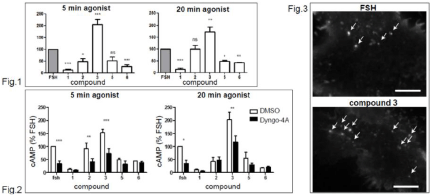| 023P Nottingham, UK 7th Focused Meeting on Cell Signalling |
Pharmacological programming of the spatial-temporal activity of gonadotrophin hormone receptors
Introduction: Follicle stimulating hormone receptor (FSHR) is a GPCR with pivotal roles in reproduction. One of the key mechanisms dictating the signal activity of GPCRs is membrane trafficking (1). After binding its endogenous ligand FSH, FSHR undergoes internalization to very early endosomes (VEEs), a heterogeneous compartment containing the adaptor protein APPL1 with distinct functions in regulating endosomal G protein signalling and APPL1-dependent recycling (2). Low molecular weight allosteric modulators have been recently developed for FSHR, for use in assisted reproductive technology instead of FSH, as these compounds are orally available and for their potential to exhibit reduced side effects (3). Our hypothesis is that these compounds lead to different signalling and/or trafficking outputs compared to FSH by targeting FSHR to distinct intracellular compartments.
Methods and Results: cAMP production was measured in HEK293 cells stably expressing FSHR and treated for 5 or 20 min with either FSH or each of the allosteric compounds, using the cAMP-Dynamic kit 2 (CisBio) (Fig.1; n=4 independent experiments; One-way ANOVA: *p<0.05, **p<0.01, ***p<0.001). To discern between plasma membrane or endosomal cAMP, cells were also pre-treated with or without the dynamin inhibitor Dyngo-4A (20 min, 50 uM) (Fig.2; n=4 independent experiments; Two-way ANOVA). The compounds exhibited a differential ability to increase intracellular levels of cAMP compared to FSH (Fig.1), with only compound 2 and 3 sensitive to inhibition of receptor internalization via Dyngo-4a (Fig.2). Furthermore, measurement of FSHR recycling, in real time at single event resolution, via TIRF, revealed that compound 3 increased the number of FSHR recycling events (Fig. 3, maximum intensity projection from a 1 min TIRF movie of a HEK293 cell stably expressing eclipticGFP-FSHR stimulated with either FSH or compound 3 for 5 min).
Conclusion: The ability of these compounds to traffic to specific VEE or early endosomal compartments and regulation by APPL1 will be assessed. Taken together, these data indicate that FSHR allosteric compounds have the potential to re-program FSHR activity by directing the receptor to different endosomal compartments.

References:
(1) Sposini S and Hanyaloglu AC (2017). Biochem Pharmacol 143: 1-9.
(2) Sposini S et al. (2017). Cell Rep 21: 2855-2867.
(3) Nataraja SG et al. (2015). Front Endocrinol 6: 142.

